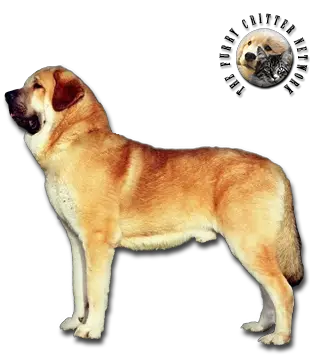Breed Standard
Head: Solid, massive, size in proportion to the body. Moderately domed skull. Stop not pronounced. Rectangular muzzle. Large nose.
Ears: Medium size, triangular, drop, hanging against the cheeks.
Eyes: Small, almond. Dark color preferred (hazel). Black rims.
Body: Massive, elongated (longer than tall). Solid, tapered neck. Thick, double dewlap. Withers slightly pronounced. Deep, broad brisket. Ribs well sprung. Long, broad loin.
Tail: Thick at the root and tapering to the tip. Hair on the tail is longer than on the rest of the body. Carried low at rest, reaching the hocks.
Hair: Heavy, thick, moderately long, smooth. Shorter on the legs.
Coat: Any color. Solid colors are preferred: yellow, fawn, red, black, wolf gray, and piebald.
Size: Dog: at least 77 cm Bitch: at least 72 cm
Weight: 50 to 65 kg
History
The Spanish Mastiff is a native to the region of Estremadura in Spain. He was for some time popular in that country. He is believed to originate from the ancient Molosser dog that can be traced back to 2000 years B.C. These dogs were probably introduced to the Iberian Peninsula by Phoenician tradesmen who had brought them from Syria or India. Mastiffs have been known to exist in Iberia for thousands of years, and the Spanish Mastiff was shown regularly at dog shows early in the 20th century, however, no Standard for the breed was drawn up until 1946. The Spanish Mastiff is a natural guard, and his inherent abilities led him to many crossings with other breeds to perfect the lesser breeds' type. It is popular in Spain as a guard of both livestock and the home. One of the dog world's truly great droolers, this old breed still guards sheep, as it has done for centuries. The Spanish Shepherd's Association, Mesta, records how this bulky breed has been an efficient protector against wolves since the 1400s. Today a lot of individuals are kept as companions. The breed may be seen in great numbers at Spanish dog shows but is still rarely seen outside the Iberian Peninsula. The Spanish Mastiff is the national dog breed of Spain and is now the most numerous of all the native Spanish dog breeds in that country; currently around 24000 Spanish Mastiffs live in Spain. The province of Leon in northwestern Spain has the largest Spanish Mastiff population in the country, particularly in the mountains. Leon is now known as the Spanish Mastiff capital. Even though the Mastin Espanol (Spanish Mastiff) is a very rare breed in other countries, this is a very popular dog in his native Spain. In fact, the breed is almost as common there as the Labrador Retriever is in North America. Some of the finest, purebred, show-quality Spanish Mastiff stock can be found in both the Madrid region of Spain and in Holland and MECA (the Mastin Espanol Club of America). The MECA is now importing and breeding stock from those regions to work toward improving the Spanish Mastiff bloodlines in North America and educating the public on the breed. However, Holland is more recommended, because in Spain, they are more likely to sell you a pet-quality dog. The Spanish Mastiff is the father of the Portuguese Rafeiro do Alentejo and has played a role in the ancestry and development of some other Mastiff breeds such as the St. Bernard, Dogo Argentino, the recently created Asian Shepherd and possibly some others Molosser breeds known today. The breed has suffered from extensive crossbreeding with foreign Mastiff breeds, such as the St. Bernard and others, during the past few decades which caused a big decline in the numbers of purebred specimens. But the Mastin is now back to its pure form. The Spanish Mastiff has been as designated as the national dog breed of Spain.
Behavior
This rustic, lively, self-confident breed has a noble bearing. He is calm, affectionate, gentle with children, and forms a close bond with his owner. The Spanish Mastiff holds his ground with predators and strangers. His bark is deep, resonant, husky, and powerful.
The Spanish Mastiff needs a lot of exercise and room to run. Regular brushing is required.
Function
Some of the Spanish Mastiff's talents include watchdog, guarding, police work, military work, tracking and hunting.
Health
Beware of hip dysplasia, heart problems and Entropion (inversion of the eyelids). Also pano-ostiosis (growing pains), which occurs when they are growing puppies. This breed is prone to bloat. It is wise to feed the Spanish Mastiff several small meals rather than one big one. Births are difficult in some Spanish Mastiffs and C-sections are often needed.






